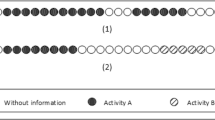Abstract
A ubiquitous environment enable us to enjoy various services “anytime” ”anywhere”. However, “everyone” is not realized. We research an intelligent space “everyone” can enjoy services. This paper proposes a method to detect user behavior to provide services according to user context in home. We focus on scenes user’s mode significantly changes, such as going out and going to bed. People often have characteristic behavior in these scenes. Our method extracts this characteristic as a behavioral pattern and detects user behavior in these scenes by matching current user behavior online with it. The method characterizes each scene with kind of objects a user touched and the order of them. The method realizes early start of providing services by creating a behavioral pattern from user behavior logs in short duration. The experiment proves the high potency of our method and discusses its weakness at the same time.
Preview
Unable to display preview. Download preview PDF.
Similar content being viewed by others
References
Kidd, C.D., Orr, R.J., Abowd, G.D., Atkeson, C.G., Essa, I.A., MacIntyre, B., Mynatt, E., Starner, T.E., Newstetter, W.: The aware home: A living laboratory for ubiquitous computing research. In: Streitz, N.A., Hartkopf, V. (eds.) CoBuild 1999. LNCS, vol. 1670, pp. 191–198. Springer, Heidelberg (1999)
Perkowitz, M., Philipose, M., Patterson, D.J., Fishkin, K.: Mining models of human activities from the web. In: WWW 2004. Proc. the 13th International World Wide Web Conference, pp. 573–582 (2004)
Isoda, Y., Kurakake, S., Nakano, H.: Ubiquitous sensors based human behavior modeling and recognition using a spatio-temporal representation of user states. In: AINA 2004. Proc. the 18th International Conference on Advanced Information Networking and Applications, pp. 512–517 (2004)
Aoki, S., Iwai, Y., Onishi, M., Kojima, A., Fukunaga, K.: Learning and recognizing behavioral patterns using position and posture of human body and its application to detection of irregular state. The Journal of IEICE (D-II) J87-D-II(5), 1083–1093 (2004)
Aoki, S., Onishi, M., Kojima, A., Fukunaga, K.: Detection of a solitude senior’s irregular states based on learning and recognizing of behavioral patterns. IEEJ Transactions on Sensors and Micromachines 125-E(6), 259–265 (2005)
Matsuoka, K.: Smart house understanding human behaviors: who did what, where, and when. In: Proc. the 8th World Multi-Conference on Systems, Cybernetics, and Informatics, pp. 181–185 (2004)
Mori, T., Takada, A., Noguchi, H., Sato, T.: Behavior prediction system based on environmental sensor records. In: INSS 2005. Proc. the 2nd International Workshop on Networked Sensing Systems, pp. 197–202 (2005)
Mori, T., Takada, A., Noguchi, H., Harada, T., Sato, T.: Behavior prediction based on daily-life record database in distributed sensing space. In: IROS 2005. Proc. the 2005 IEEE/RSJ International Conference on Intelligent Robots and Systems, pp. 1833–1839 (2005)
Yamazaki, T.: Ubiquitous home: Real-life testbed for home context-aware service. In: Tridentcom 2005. Proc. the 1st International Conference on Testbeds and Reserch Infrastructures for the DEvelopment of NeTworks and COMmunities, pp. 54–59 (2005)
Nakauchi, Y., Noguchi, K., Somwong, P., Matsubara, T., Namatame, A.: Vivid room: Human intention detection and activity support environment for ubiquitous autonomy. In: Proc. the 2003 IEEE/RSJ International Conference on Intelligent Robots and Systems, pp. 773–778 (2003)
Aoki, S., Onishi, M., Kojima, A., Fukunaga, K.: Recognition of behavioral pattern based on hmm. The Journal of IEICE (D-II) J85-D-II(7), 1265–1270 (2002)
Hara, K., Omori, T., Ueno, R.: Detection of unusual human behavior in intelligent house. In: Proc. Neural Networks for Signal Processing XII - proceedings of the 2002 IEEE Signal Processing Society Workshop - 2002, pp. 697–706. IEEE Computer Society Press, Los Alamitos (2002)
Fukuda, T., Nakauchi, Y., Noguchi, K., Matsubara, T.: Time series action support by mobile robot in intelligent environment. In: ICRA 2005. Proc. 2005 IEEE International Conference on Robotics and Automation, pp. 2908–2913. IEEE Computer Society Press, Los Alamitos (2005)
Nishida, Y., Kitamura, K., Aizawa, H.: Real world sensorization for observing human behavior and its application to behavior-to-speech. In: IUI 2004. Proc. International Conference on Intelligent User Interface 2004, pp. 289–291 (2004)
Kaede, S., Yamahara, H., Noguchi, T., Shimada, Y., Shimakawa, H.: A probabilistic approach to recognize individual behavior from touched objects. IPSJ Journal 48(3) (2007)
Author information
Authors and Affiliations
Editor information
Rights and permissions
Copyright information
© 2007 Springer-Verlag Berlin Heidelberg
About this paper
Cite this paper
Yamahara, H., Takada, H., Shimakawa, H. (2007). Detection of User Mode Shift in Home. In: Ichikawa, H., Cho, WD., Satoh, I., Youn, H.Y. (eds) Ubiquitous Computing Systems. UCS 2007. Lecture Notes in Computer Science, vol 4836. Springer, Berlin, Heidelberg. https://doi.org/10.1007/978-3-540-76772-5_14
Download citation
DOI: https://doi.org/10.1007/978-3-540-76772-5_14
Publisher Name: Springer, Berlin, Heidelberg
Print ISBN: 978-3-540-76771-8
Online ISBN: 978-3-540-76772-5
eBook Packages: Computer ScienceComputer Science (R0)




